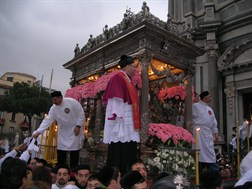The changes in a feast
 However if one could observe the development of the feast of Saint Agatha how it developed at the height of the Baroque era, in the sixteenth and seventeenth centuries, they would no longer recognize it. At that time, even though candles existed in the procession, the cannalore were decorated to the point that they took on the form of veritable allegorical carts that changed every year. The fercolo also was entirely carried on the shoulders of devotees (and therefore was not pulled) who were dressed in nothing but a thong and went barefoot, hence they were called the ignudi, the naked.
However if one could observe the development of the feast of Saint Agatha how it developed at the height of the Baroque era, in the sixteenth and seventeenth centuries, they would no longer recognize it. At that time, even though candles existed in the procession, the cannalore were decorated to the point that they took on the form of veritable allegorical carts that changed every year. The fercolo also was entirely carried on the shoulders of devotees (and therefore was not pulled) who were dressed in nothing but a thong and went barefoot, hence they were called the ignudi, the naked.
The cry of “cittadini fedeli!” (all loyal citizens!) was not yet widespread, and they limited themselves to shouting “Viva Sant’Agata!” (Long live Saint Agatha!), often accompanied by shouts of olé. The call to the citizens dates back to the nineteenth century.
The women, on the contrary, were much more dressed than today. The majority wore a white handkerchief on their heads turned to one side so as to leave only the eyes uncovered and hence this way of donning it was called gli occhiali (the glasses). The more devout then wore a black veil that completely hid their faces and they were called the ‘ntuppatedde.
Before the eruption of 1669, moreover, the arrival of the lava changed the shape of the area in the southeast of the city, the one where the fercolo then journeyed on the afternoon of 4 February, and where, on a plateau, a horse race was held, called the ginetti.
Only after the earthquake of 1693 was a contest of songs introduced, a custom which was interrupted in the sixties of the twentieth century. At the passage of the fercolo in front of the archdiocesan seminary, the seminarians used to merrily roll strips of paper, the so-called strisciata (swiping).
Originally, the fercolo went about the city for just one day, 4 February. On 3 February, a procession was held called the luminaria (illumination): a sign of devotion in which the votive candles offered to the saint which extinguished were paraded. The second procession, that of the 5, is more recent. Only after the Second World War, has the fercolo been of interest for the village, now a district of the city but for a long time an independent village which held its own small, special feast of Saint Agatha. The greatest difference in the way in which the ceremony was performed in the Baroque period, however, was the presence of the flagellants, individuals penitents who ritually flagellated themselves or hurt their bodies.
